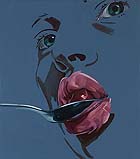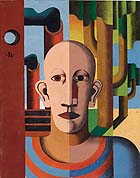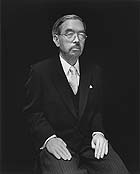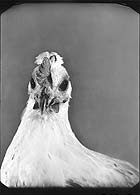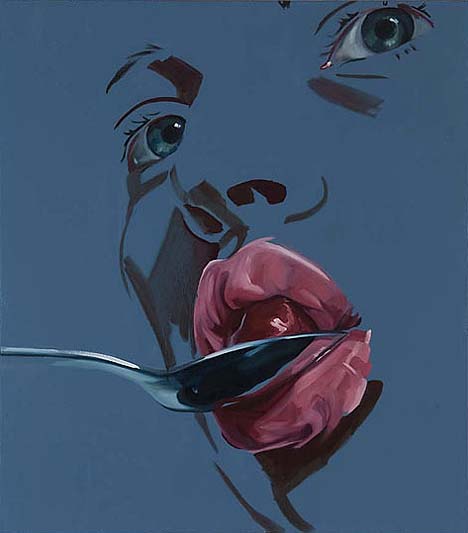
translated and summarized by: Liz Wollner-Grandville,
English summary May 5 - 12
LukasFeichtner Galerie: Bianca Regl
Of working at ecstasy
A twisted half naked woman, a spoon just about to enter a mouth– these are some of the Bianca Regl’s (born 1980) works that are shown in the gallery’s foyer. But the first view could be deceiving – these works having nothing to do with the platitudinous aesthetics of advertisements, they represent remarkable art. The paintings in the back rooms show a differentiated picture. Fish that are just about to be eaten, stare down at you with lifeless round eyes. Abstract fruits in their own juice, even if technically only insinuated, but nevertheless offering realistic details, or a man in a swimming pool, dominate the subjects.
If these technically perfect works wouldn’t convey that they want to be something they aren’t – namely ecstatic expression, this young artists solo exhibit would be even more convincing. These oil paintings and drawings impress by their depiction of superficiality; how things present themselves without having any overloaded significance.
The artist’s strengths become apparent in the way she captures the small, everyday objects. And the unostentatious and reserved portraits, displayed on the lower floor of the exhibit, convince through their unobtrusive serenity, which allows the onlooker to project his/her own feelings and thoughts into the painting.
Whoever thinks that traditional technical skills are no longer relevant in today’s art world will be disabused by this exhibit. Even the older masters could not have done better.
LukasFeichtner Galerie
1010 Vienna, Seilerstätte 19, until 21. 05. 08
www.feichtnergallery.com
Museum Ludwig: köln progressiv 1920 – 33 seiwert–hoerle–arntz
A humane world for all
The connection between carnival and Karl Marx is not the first thought that comes to your mind when you think about Cologne. The Rhenish way of life and the ideological doctrine do not have much in common. However, the philosopher published a newspaper in Cologne and the artists, whose work is currently displayed at an exhibit in the Museum Ludwig, were Marxists and loved carnivals. Paintings and graphic prints by three significant Progressive Artists are shown at the “köln progressiv 1920 – 33. seiwert-hoerle-arntz”. Their works have an exceptional position in the art of the Weimar Republic.
Together with the wood carver Gerd Arntz, the painters Franz W. Seiwert and Heinrich Hoerle founded the group at the beginning of the 20s – strongly influenced by the World War and the revolution. They stood for the values of a humane society and art should help reach this goal.
The Progressives were persecuted by the Nazis and later fell into oblivion. They were rediscovered by the influence of the 1968 movement, however mainly focusing on the political aspects of their work; today this focus has shifted to their artistic values. The exhibit shows colourful, modern, nearly tactile paintings, which were created in contrast to the smooth classical techniques of the New Objectivity (Neue Sachlichkeit). This differentiated concept of painting expressed the solidarity and esteem with the working world and workers.
The exhibit displays 50 paintings and 80 graphic prints from international museums, private collections, as well as the Museum Ludwig’s own collection.
Museum Ludwig
50667 Cologne, Bischofsgartenstr. 1, until 15.06.08
www.museenkoeln.de/museum-ludwig
Museum der Moderne Salzburg Mönchsberg: Hiroshi Sugimoto
Discourse enhancer
Hiroshi Sugimoto is one of those artists who make us assume that we have already seen all of his work. The “Theatres”: with the open aperture throughout the entire performance, which makes the entire film coagulate into a white plane, and the visitors dissolve into invisible ghosts - all of this is well known, clear, and beautiful. Or the “Portraits”: Henry VIII with his wives, much more realistic than they really were, scary, eerie. And the “Seascapes”: the horizon positioned exactly in the middle, sky and sea melt into one other, everyone describes it as being meditative, but sometimes it can get a little boring.
All this – and more - is shown at the Sugimoto exhibit at the Museum on the Mönchsberg. The works displayed, which were positioned by Sugimoto himself, include the rarely shown blurry photographs of modern architectural icons: Erich Mendelsohn’s Einstein Tower, Le Corbusier’s Villa Savoye. Walter Gropius’ Fagus factory, and Frank Lloyd Wrights’ Guggenheim. All of them are clearly recognizable, a fact that reveals their outstanding landmark character. Among the works are also the dioramas that he had photographed in the American Museum of Natural History in the 70s. “No matter how artificial an object might be, once photographed, it is almost real”, Sugimoto once said. Photography has always dealt with the question of where deception begins and reality ends. This discourse is significantly enhanced by Sugimoto: he lets artificial objects appear real and real objects appear unreal.
Museum der Moderne Salzburg Mönchsberg
5020 Salzburg, Mönchsberg 22, until 15. 06.08
www.museumdermoderne.at
Mannheimer Kunstverein: SchauM
Orchestrated hype
The exhibit commemorating the 175th anniversary of the Mannheimer Kunstverein aimed at being an event everyone will remember. Andrea Domesle and Jessica Beebone were nominated by the Kunstverein to curate the display and were asked to “really shake and turn the Kunstverein upside down”. And they definitely succeeded.
The works of the 20 international artists have the power to transform the space in which they are displayed or to intensively deal with the act of “seeing”. (This could also be an explanation for the word-creation “SchauM”, which is as a combination of the German word for “seeing” (schauen) and the “M” could stand for “Mannheim”).
Both the artists as well as the curators really “made a change” to the existing space. The entrance of the building was shifted to the back building. A steel staircase first leads to the roof, where “Trinity” the artwork by Bernhard Bretz and Mathias Holliger is displayed, and from here one can then enter the inner part of the building. At the actual entrance, between two glass doors, Tinka Stock positioned an installation, which is perceivable both from the in- as well as the outside. In the foyer two monitors are set up back-to-back; through Andrea Loux’s video installation they mutate into a kind of continuous closet room through which she climbs like a sleek cat.
The works not only make reference to the showroom, or to the topic “space” and “seeing”, but also develop dialogs among one another - something one could also describe as a successful orchestral structure.
Mannheimer Kunstverein
68165 Mannheim, Augustaanlage 58, until 25. 05. 08
www.mannheimer-kunstverein.de
Mehr Texte von translated and summarized by: Liz Wollner-Grandville


 Teilen
Teilen

